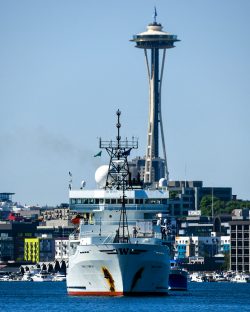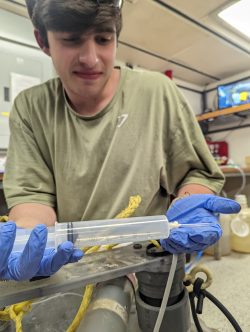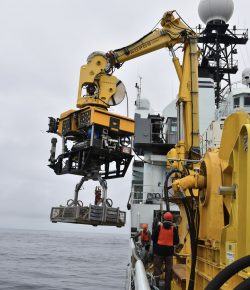
Most things that humans build need a little maintenance every now and again. That’s no different for the Regional Cabled Array, a high-tech engineering marvel off the Pacific Northwest coast studded with all kinds of oceanographic equipment that gives humans a real-time, 24/7 look at what’s happening under the sea surface. The lengths that scientists and engineers go to keep the array working and up to snuff is extraordinary, and they are currently at sea providing its annual check-up.
“There are about 60 people we’ve sent offshore for 45 days with over 200,000 pounds of gear,” says lead project investigator Debbie Kelley. The team departed Newport, OR in early August aboard the R/V Thomas G. Thompson, a 274-foot research vessel whose home is at the University of Washington’s School of Oceanography. Onboard is a state-of-the-art robotic vehicle called ROPOS, the workhorse that will take instruments to and from the seafloor and deep ocean. “It’s a lot to manage, but we have such an exceptional team that gets along, works efficiently and is great at their job. Which is good because being at sea for that long is tough.”
The cabled array’s massive infrastructure, including over 500 miles of submarine high-power and bandwidth fiber optic cables connected to nearly 150 instruments offshore, is designed to collect enormous amounts of scientific data in real time continuously for 25 years. Located in deep Pacific waters, data are specifically collected at two areas offshore of Oregon: Axial Seamount, the largest underwater volcano off the coast, and along the continental margin, including where the Juan de Fuca Plate dives under the North American Plate. Scientific equipment, both stationary and mobile, measure and record information about what’s happening in these dynamic environments, including changes in seawater pH, temperature, salinity, seafloor earthquakes, volcanic eruptions and the life that flourishes in the unique conditions at each site. The array — which operates under the larger NSF-funded Ocean Observatories Initiative — has been collecting data in our region since 2014 for anyone in the world to freely use.

While keeping the cabled array fully functioning is important and exciting work, Kelley finds equal excitement in bringing 28 students on the cruise this year as part of the UW at-sea experiential learning program called VISIONS. Both graduates and undergraduates will get to experience firsthand what doing research is like on the high seas, working side-by-side with the ROPOS team as the vehicle dives nearly 10,000 feet below the ocean’s surface. Students will study the unique organisms that live in such harsh environments, and collect data, imagery, and maintain infrastructure as it comes aboard. Two students are doing their senior thesis at the Axial volcano, collecting animals and microbes that live in the extreme temperatures and pressures of hydrothermal vents — where water is superheated by magma — and decoding their genetics. The students hail from around the globe, with hometowns in the Pacific Northwest, Saudi Arabia, India, Kazakhstan and beyond, and their disciplines range from oceanography and marine biology to engineering and computer science.
“They will gain an awareness of the ocean during a blue-water cruise 300-miles offshore,” says Kelley. “That’s just cool stuff, right?”
An experience like this for students can be a once-in-a-lifetime opportunity. “Anyone, no matter their interest, should try to come to sea,” says Andrew Paley, an undergraduate majoring in marine biology and oceanography. His interest is on the deep sea and what lives there, and he wants to understand exactly how operations like this run and how to plan them. “You get to see things only a fraction of the population will ever think about, whether that be the tube worms, weird fish, dolphin pods, whales, albatross or the 360 degrees of endless stars that are only possible in the ocean.”

Onboard, Paley is building multiple skill sets, including those needed in the laboratory which he and many other students have gone without during the age of COVID and online labs. His other duties include preparing scientific instruments for deployment, processing samples brought back to the ship, and keeping meticulous notes about what’s happening at sea. His days are anything but consistent, as he tends to switch from task to task based on what’s needed. A good chunk of his time is spent as a watch lead, where he serves as a resource and helping hand for students that need it. He is often found answering their questions about what’s happening during ROV dives, and helps identify all the critters they see on camera. “That’s become something of a specialty of mine,” he says.
Since its inception, the cabled array has recorded spectacular events that escape notice in our day-to-day lives. The ocean is a harsh, ever-changing environment, and for the most part invisible to humans; yet this project has given us a window into what’s happening on the ocean floor, and throughout the water column—providing a greater understanding of how the Earth works.
For example, 70% of volcanism on Earth occurs in the ocean, but people almost never see these eruptions hidden beneath the waves. In 2015, instruments on the summit of Axial Seamount changed all that, and scientists were able to document the start and evolution of a massive eruption. They knew it was coming because seismometers — devices that can detect even the tiniest of earthquakes — placed earlier on the seafloor recorded approximately 8000 earthquakes over a period of 24 hours. These earthquakes were too small to be detected on land. As the eruption began, scientists watched the seafloor fall nearly seven feet, all while recording over 30,000 explosions as lava fountained and spilled onto the seafloor nearly a mile beneath the ocean’s surface. Three months later they were able to pilot ROPOS to the still-cooling, nearly 400-foot-thick lava flow and document swarms of microbes issuing from within it, fed by chemicals and gasses in the lava that give them life.

Another example involves monitoring methane seeps along the margin off Newport, Oregon. Here, methane gas escapes through vents in the seafloor, which has both energy and greenhouse gas implications. There are over 1000 methane bubble-plumes spanning the coast from Oregon to Vancouver Island, but only a handful of these sites have ever been directly imaged. With sonars and cameras on the array, scientists monitoring the methane bubbles can watch them move towards the ocean’s surface where they feed microbial communities, which in turn feed planktonic communities, which in turn feed krill that eventually become food for whales and other marine life.
But even with all the science and discovery, Kelley’s biggest joy remains taking the students to sea. “Some of the students I have known since 2014, some go to grad school, one is currently in the White House,” she says. “It’s a long-term relationship we build, and many say that participating in these expeditions has forever changed their lives. They get to experience something that few get to do. I love working with the students and helping to open their eyes about what a remarkable place our oceans are.”
Visit the OOI Regional Cabled Array’s website for more information about this year’s cruise.
And check out their live video feed of what’s happening on the seafloor.
Read the student’s blogs about their experience at sea.
Story by John Meyer

